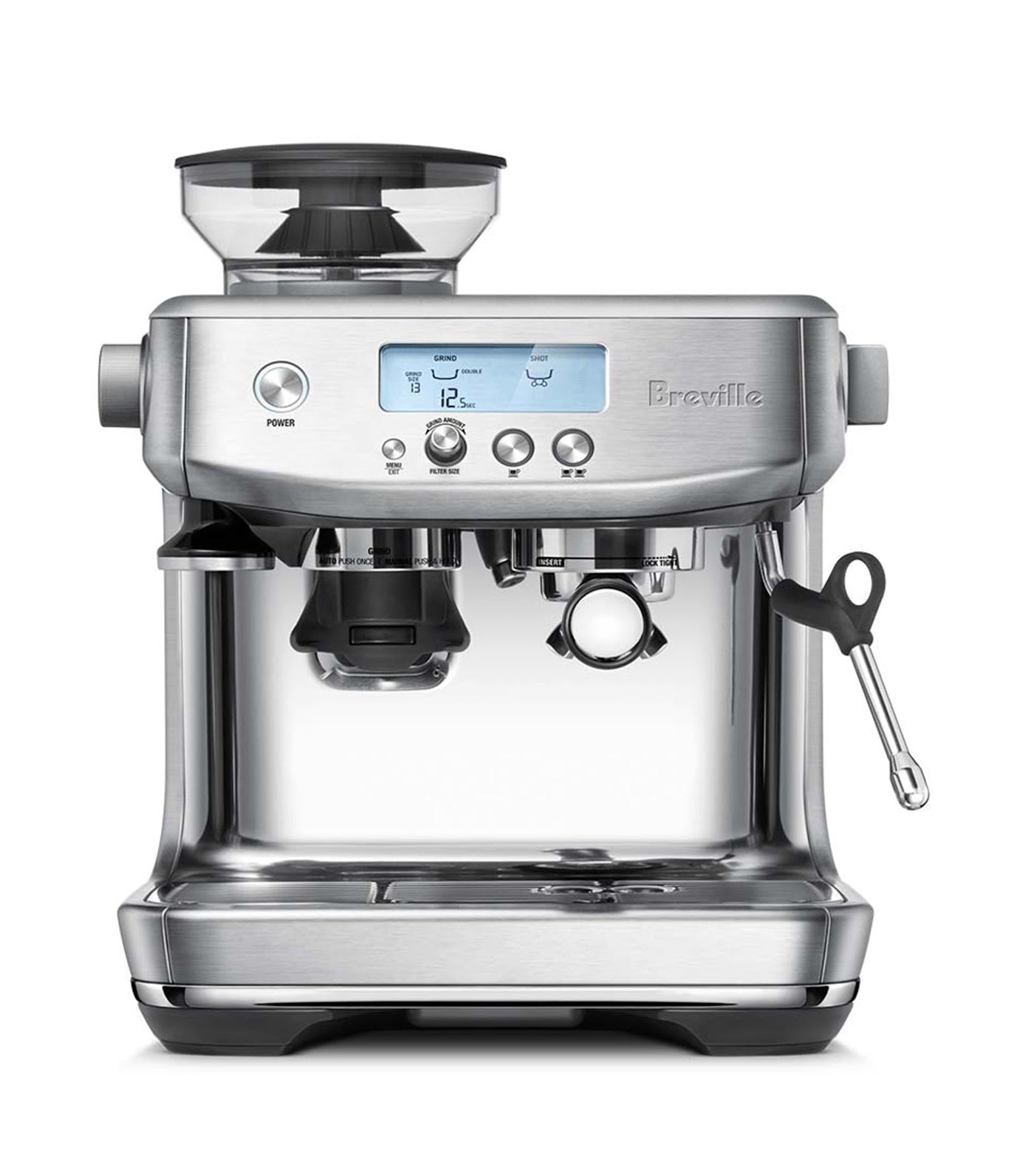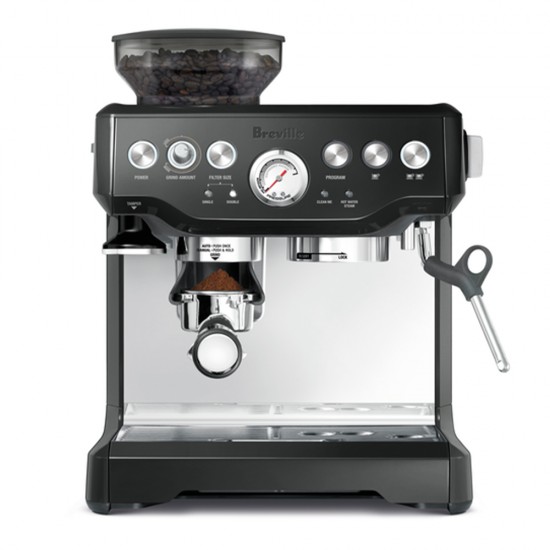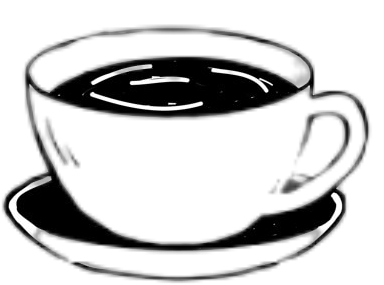#1: Breville Barista Pro

- Fast heat-up time
- Intuitive LCD display for easy operation
- Precise espresso extraction with built-in grinder
#2: Breville Barista Express

- Built-in grinder for fresh coffee
- Affordable for its features
- Solid and durable build quality
If you’re a coffee lover like me, you know that making espresso at home can be a game-changer. it came time to upgrade my espresso setup, I found myself deciding between two of Breville’s popular models: the Breville Barista Pro and the Breville Barista Express. After using both, I’ll share why the Barista Pro has a clear edge, especially if you value speed, customization, and a modern interface. Below, I’ll walk through the differences and my experience with each machine.
Barista Pro

Barista Express

First Impressions: Breville Barista Pro vs Express
I first set up both machines, the Barista Pro immediately felt more advanced. It has a sleek design and features a bright LCD display that gives it a modern look, making it easy to see settings and adjust the machine to my needs. In comparison, the Barista Express has a more traditional, analog appearance with dials and buttons. While it’s still functional, it doesn’t have the same polished, high-tech feel as the Pro.
Both machines have sturdy stainless steel bodies and feel durable, but the Pro’s design fits better with modern kitchens. I also found the retractable power cord on the Pro to be a nice touch—it helps keep the counter tidy, which is a small but appreciated convenience.
Heating Time: A Major Advantage in Breville Barista Pro vs Express
Breville Barista Pro: Super-Fast Heat-Up
The Barista Pro uses Breville’s ThermoJet heating system, allowing it to reach brewing temperature in just 3 seconds. This feature was a lifesaver for me in the mornings when I wanted coffee immediately without waiting. With the Pro, I could start brewing almost as soon as I turned it on. This rapid heating also made it easy to make multiple drinks in a row.
Breville Barista Express: Slower but Reliable
In contrast, the Barista Express has a ThermoCoil heating system that takes around 30-45 seconds to reach optimal temperature. While it’s still fairly quick, it doesn’t compare to the Pro’s instant heat-up. For some, this difference may not seem major, but for me, the Pro’s fast heating made a noticeable impact on my coffee routine, especially on busy days.
Barista Pro

Barista Express

User Interface and Controls: Breville Barista Pro vs Express
Breville Barista Pro: Digital Precision and Simplicity
One of the standout features of the Barista Pro is its LCD display, which makes adjusting settings incredibly easy. The digital interface clearly shows shot timing, grind size, and other key settings, which allowed me to tailor each espresso shot precisely. I found it intuitive, especially for adjusting brew time and shot volume. This feature has made a big difference in how I brew because I don’t have to rely on guesswork.
Breville Barista Express: Manual but Effective
The Barista Express, while still user-friendly, lacks a digital display and instead uses dials and buttons. This setup works well for standard brewing, but I found it less precise and harder to navigate. For those who prefer simplicity, the Express’s manual controls may feel more approachable. However, if you like to fine-tune settings or see exactly what you’re adjusting, the Pro’s digital interface is a game-changer.
Espresso Quality: Breville Barista Pro vs Express
Breville Barista Pro: Enhanced Flavor Control
The Barista Pro’s control over grind size and shot timing has allowed me to get consistently great espresso. The Pro has 30 grind settings, which means I can adjust the grind more precisely than on the Express. This control helped me get the most flavor out of different beans, bringing out subtle notes I hadn’t noticed before. This kind of precision is fantastic for anyone who likes to experiment with different roasts.
Breville Barista Express: Reliable Quality, Less Customization
The Barista Express also makes quality espresso, and for someone who’s not as focused on the fine details, it’s a solid choice. It has 18 grind settings, which still offers some customization but isn’t as flexible as the Pro. The coffee it produces is robust and rich, and I think the average user would be satisfied with it. However, if you want that extra bit of control over flavor, the Pro has the edge.
Steaming and Frothing Milk: Breville Barista Pro vs Express
Breville Barista Pro: Fast and Efficient Steam Wand
The Pro’s steam wand heats up in about 3 seconds and creates a silky, microfoam texture perfect for lattes and cappuccinos. This speed makes it convenient for making multiple milk-based drinks, which I often do when entertaining. The steam quality also enables me to create latte art with ease, as the microfoam is consistently smooth and fine.
Breville Barista Express: Good Steam, But Slower
The Barista Express takes around 30 seconds to reach steam temperature and about 75 seconds to fully froth the milk. While it still makes good microfoam, it’s noticeably slower than the Pro. If you’re only making one or two milk-based drinks occasionally, this may not matter, but if you’re someone who frequently makes lattes, the Pro’s speed is a big advantage.
Maintenance and Cleaning: Breville Barista Pro vs Express
Both machines are relatively easy to clean and maintain, with similar requirements for descaling and filter replacement. However, I appreciated the Pro’s digital interface, which provides reminders and step-by-step instructions for maintenance. These prompts made it easier to keep the machine in top condition without having to check the manual constantly.
Price and Value: Breville Barista Pro vs Express
Breville Barista Pro: Worth the Investment for Coffee Enthusiasts
The Pro is priced higher than the Express, but I believe the additional features make it a worthwhile investment. The fast heat-up time, digital display, and greater control over grind and brew settings all contribute to a better coffee experience, especially for those who are serious about their espresso. If you’re someone who values these features, the Pro offers excellent value.
Breville Barista Express: Great Option for Those on a Budget
The Express is more budget-friendly and still produces great espresso. It’s an ideal choice for someone who wants quality coffee without the extras. If you’re new to espresso or prefer a simpler machine, the Express provides a fantastic introduction without overwhelming you with too many options.
Who Should Buy the Breville Barista Pro?
I’d recommend the Barista Pro to anyone who wants more customization and a faster workflow. If you’re someone who appreciates having full control over espresso variables, the Pro’s digital display and grind flexibility are ideal. It’s also perfect if you frequently make multiple drinks or need a quick brewing process, as the ThermoJet system saves significant time.
Who Should Buy the Breville Barista Express?
For those who prefer a simpler setup or are on a tighter budget, the Barista Express is a fantastic option. It’s easy to use, produces quality espresso, and offers some level of customization without being too complex. It’s especially great for beginners or those who want reliable espresso without the need for advanced settings.
Product Review Conclusion: Breville Barista Pro vs Express
After spending time with both the Breville Barista Pro and the Barista Express, I’d say the Breville Barista Pro is the better option for anyone who’s serious about espresso and values control, speed, and a user-friendly digital interface. The Pro’s fast heat-up time, LCD display, and enhanced customization make it a premium choice, especially for those who enjoy experimenting with their espresso.
The Barista Express, while still an excellent machine, is best suited for users who want a straightforward, budget-friendly option. It’s reliable, easy to use, and provides good espresso quality, making it ideal for beginners or those who prioritize simplicity. However, if you’re looking for a machine that goes beyond the basics and offers a bit more precision, the Barista Pro stands out as the superior choice. It’s worth the investment for anyone looking to elevate their at-home coffee experience.
Frequently Asked Questions: Breville Barista Pro vs Express
Q1: What are the main differences between the Breville Barista Pro and the Breville Barista Express?
A: The biggest differences are in heating speed, user interface, and customization options. The Barista Pro has a ThermoJet heating system, allowing it to heat up in just 3 seconds, while the Express takes about 30–45 seconds. The Pro also features a digital LCD display for easier navigation and customization, whereas the Express uses a dial and button interface. Additionally, the Pro has more precise grind control, offering 30 settings compared to the Express’s 18 settings.
Q2: Does the Breville Barista Pro make better coffee than the Barista Express?
A: Both machines are capable of making high-quality espresso, as they use similar components for extraction and milk frothing. However, the Pro’s digital display and faster heat-up time can help users achieve more consistent results, especially for those who like to fine-tune settings.
Q3: Is the Barista Pro’s digital display necessary, or is it just an extra feature?
A: The digital display on the Barista Pro is very helpful, especially if you like to adjust settings like shot time and grind size. It provides visual guidance, making the espresso-making process smoother and more user-friendly. For beginners or those who want more control, the display is a valuable feature.
Q4: How does the heat-up time compare between the Barista Pro and the Barista Express?
A: The Barista Pro heats up in just 3 seconds, thanks to its ThermoJet heating system, making it faster than the Express, which takes approximately 30–45 seconds to reach optimal temperature. This faster heat-up time is a major advantage for those who want a quick coffee-making process.
Q5: Is the steam wand better on the Barista Pro or the Barista Express?
A: The steam wands on both machines are high-quality and can create microfoam for latte art, but the Pro’s steam wand heats up faster (about 3 seconds) due to the ThermoJet system. This makes it more efficient for making multiple milk-based drinks back-to-back.
Q6: Does the Barista Pro allow for more grind settings than the Barista Express?
A: Yes, the Barista Pro offers 30 grind settings, giving users more control over grind size and allowing for finer adjustments. The Barista Express has 18 grind settings, which still provides good control but is slightly more limited.
Q7: Are both machines easy to clean and maintain?
A: Yes, both the Barista Pro and Barista Express have similar maintenance requirements, including regular cleaning and descaling. The Pro’s digital display can provide reminders and step-by-step instructions for maintenance, which can make cleaning easier. Both models come with a cleaning kit and include features to help keep the machines in top shape.
Q8: Is there a significant price difference between the Breville Barista Pro and Express?
A: Generally, the Barista Pro is more expensive than the Barista Express due to its advanced features like the ThermoJet heating system and digital display. The Barista Express is a more budget-friendly option, but the Pro offers extra features that might be worth the investment for coffee enthusiasts.
Q9: Which machine is better for beginners, the Barista Pro or the Barista Express?
A: The Barista Express may be better for beginners due to its simpler dial and button controls, as it’s a straightforward machine with fewer settings to manage. However, the Barista Pro’s digital display provides helpful guidance, making it easy for beginners to learn and adjust settings as they become more experienced.
Q10: Can I make latte art with both the Barista Pro and Barista Express?
A: Yes, both machines have steam wands capable of creating microfoam for latte art. However, the Pro’s faster heat-up time makes it more efficient, especially if you’re making multiple milk-based drinks. The quality of the foam is similar, but the Pro’s speed gives it a slight edge for latte art enthusiasts.
